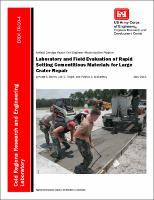Please use this identifier to cite or link to this item:
https://hdl.handle.net/11681/8467Full metadata record
| DC Field | Value | Language |
|---|---|---|
| dc.contributor | Geotechnical and Structures Laboratory (U.S.) | - |
| dc.contributor | United States. Air Force Civil Engineer Support Agency | - |
| dc.contributor | Airfield Damage Repair Civil Engineer Modernization Program (U.S.) | - |
| dc.contributor.author | Barna, Lynette A. | - |
| dc.contributor.author | Tingle, Jeb S. | - |
| dc.contributor.author | McCaffrey, Patrick S. | - |
| dc.date.accessioned | 2016-06-20T13:27:05Z | - |
| dc.date.available | 2016-06-20T13:27:05Z | - |
| dc.date.issued | 2010-05 | - |
| dc.identifier.uri | http://hdl.handle.net/11681/8467 | - |
| dc.description | Technical Report | - |
| dc.description | Abstract: Current practice for expedient runway repair dictates capping either a crushed stone or sand grid repair with a foreign object damage (FOD) cover. In recent testing, the heavy loading characteristics of transport aircraft have been shown to reduce the performance life of these types of repairs. Repairs capped with concrete are limited by time requirements, equipment, and available materials. Short set times, rapid strength gain, good durability, and satisfactory flexibility to resist the punishment of repeated heavy aircraft loads are beneficial characteristics of rapid setting cementitious materials. However, the use of these materials has been limited due to short working times, health concerns, and excessive shrinkage cracking. Improvements in rapid setting materials have allowed their use to become more common in pavement construction and repair projects, particularly when the operational tempo is critical to avoid penalty. Numerous commercial products are available. A full-scale field test was conducted using rapid setting materials to repair simulated bomb craters in an airfield. The repaired sections cured for 4 hr and were trafficked using a load cart equipped with an F-15E aircraft tire. The target service life of the repair was between 100 and 5,000 passes of the load cart. Results from this study were incorporated into Air Force guidance addressing the use of rapid setting materials for crater repair. This report describes the repair methods and performance of the rapid setting materials used in the full-scale field test to repair large craters. | - |
| dc.publisher | Cold Regions Research and Engineering Laboratory (U.S.) | - |
| dc.publisher | Engineer Research and Development Center (U.S.) | - |
| dc.relation | http://acwc.sdp.sirsi.net/client/en_US/search/asset/1005781 | - |
| dc.relation.ispartofseries | ERDC TR ; 10-4. | - |
| dc.rights | Approved for public release; distribution is unlimited. | - |
| dc.source | This Digital Resource was created in Microsoft Word and Adobe Acrobat | - |
| dc.subject | Accelerated testing | - |
| dc.subject | Airfield damage repair | - |
| dc.subject | Airfield pavements | - |
| dc.subject | Airfield runways | - |
| dc.subject | F-15E | - |
| dc.subject | Large crater | - |
| dc.subject | Cratering | - |
| dc.subject | Performance monitoring | - |
| dc.subject | Rapid setting cementitious material | - |
| dc.title | Laboratory and field evaluation of rapid setting cementitious materials for large crater repair | - |
| dc.type | Report | en_US |
| Appears in Collections: | Technical Report | |
Files in This Item:
| File | Description | Size | Format | |
|---|---|---|---|---|
| ERDC-TR-10-4.pdf | 3.59 MB | Adobe PDF |  View/Open |